ACR Electronics ACR-SART-PF-3 Search and Rescue Radar Transponder User Manual Y1 03 0171 TelluSART Manual
ACR Electronics, Inc. Search and Rescue Radar Transponder Y1 03 0171 TelluSART Manual
Contents
- 1. Product Manual
- 2. ACRSA Product Manual
- 3. NAT Product Manual
ACRSA Product Manual
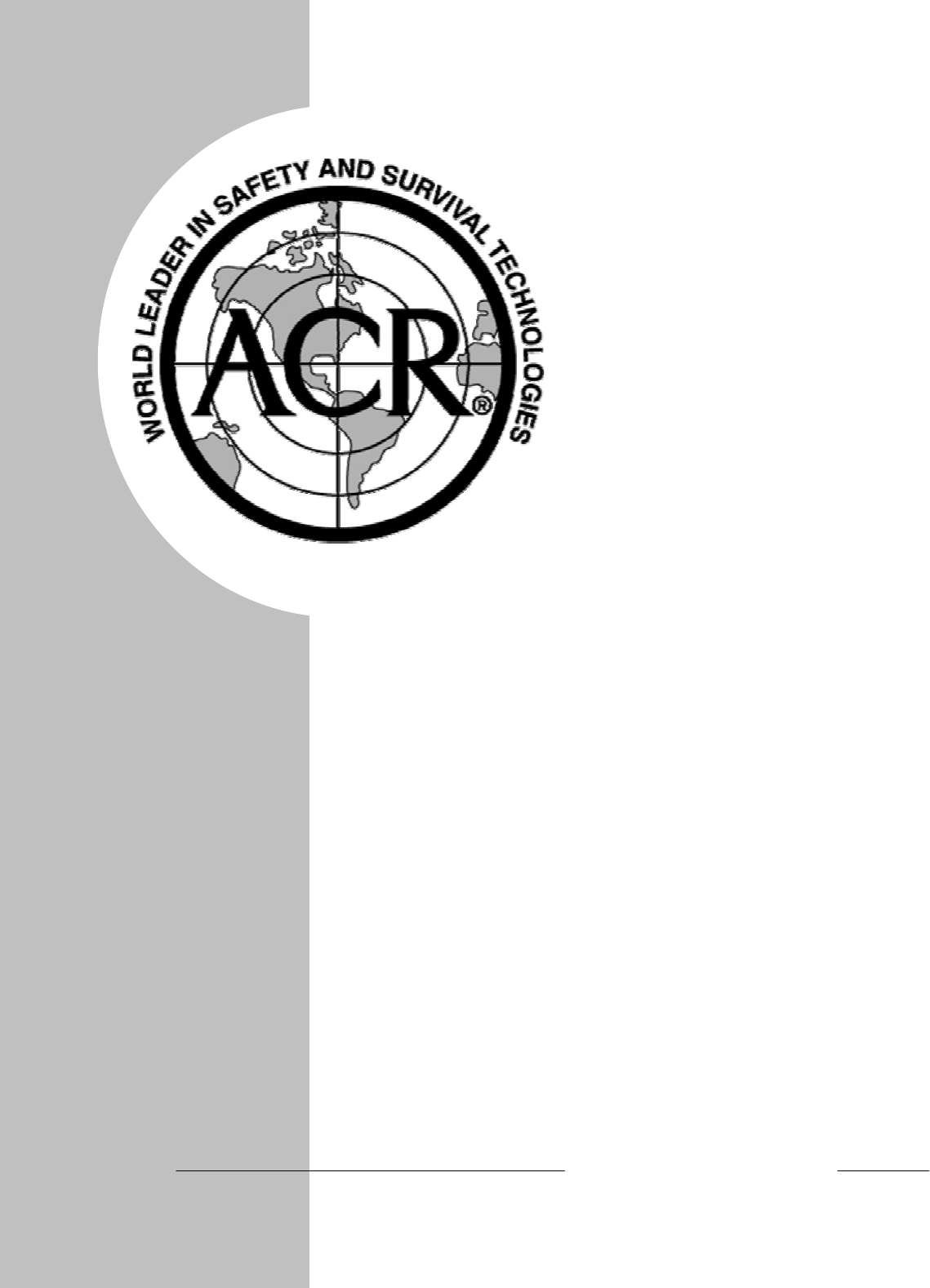
1 Y1-03-0171 Rev. A
PRODUCT
SUPPORT
MANUAL
Y1-03-0171
Rev. A
TelluSART MK III
Product No. 2716
FCC ID. B66ACR-SART-PF-3
Search and Rescue
Transponder (SART)
ACR South Africa.
A division of Chelton Avionics (Pty) Ltd.
95a Main Road
Somerset West
7130
Western Cape
South Africa
Telephone: ++27-21-852-7583
FAX: +27-21-851-1535
Email: technical@acrsa.co.za
A
Chelton Group
company

2 Y1-03-0171 Rev. A
Forward
Congratulations and thank you for purchasing the ACR TelluSART MK III Search and Rescue
Transmitter. The combination of superior design, high quality raw materials and quality
controlled manufacturing produce a product that will perform for years to come. The Test
Facility at ACR can reproduce some of the harshest environmental conditions known to man.
This assures that the products we produce can stand up to the rigors found in a marine
environment. With proper care and maintenance, your SART will be in service for years to
come.
ACR is proud to be certified to the ISO 9001, the international Standard for Quality.
This manual provides installation, operation and maintenance instructions for the TelluSART
MK III SART, hereinafter referred to as the SART. This manual also describes the
characteristics and details of the SART system. This SART has been tested and approved to IEC
1097-1 standards and meets the requirements of GMDSS according to chapter III of the 1974
SOLAS.
Contents
Warning notice..................................................................................................................................... 3
SART Overview................................................................................................................................... 4
Introduction.......................................................................................................................................... 5
Specification ........................................................................................................................................ 7
Vessel name ......................................................................................................................................... 8
Life raft stowage .................................................................................................................................. 8
Activation............................................................................................................................................. 9
Sequence of Operations ...................................................................................................................... 10
Pole mounted SART ........................................................................................................................... 11
Hanging SART.................................................................................................................................... 12
Vessel Mounting / Ship installation.................................................................................................... 13
Maintenance and Testing.................................................................................................................... 15
Servicing ............................................................................................................................................. 16
Battery Pack Replacement .................................................................................................................. 16
Transportation..................................................................................................................................... 17
Technical Specifications..................................................................................................................... 18
Warranty Information ......................................................................................................................... 20
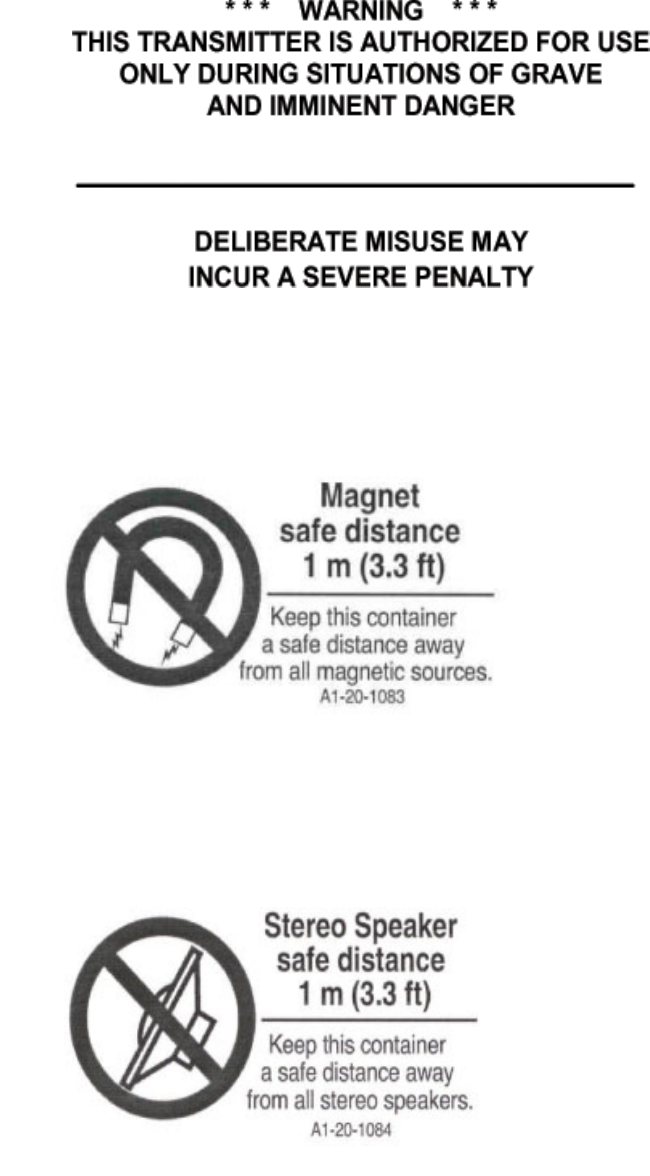
3 Y1-03-0171 Rev. A
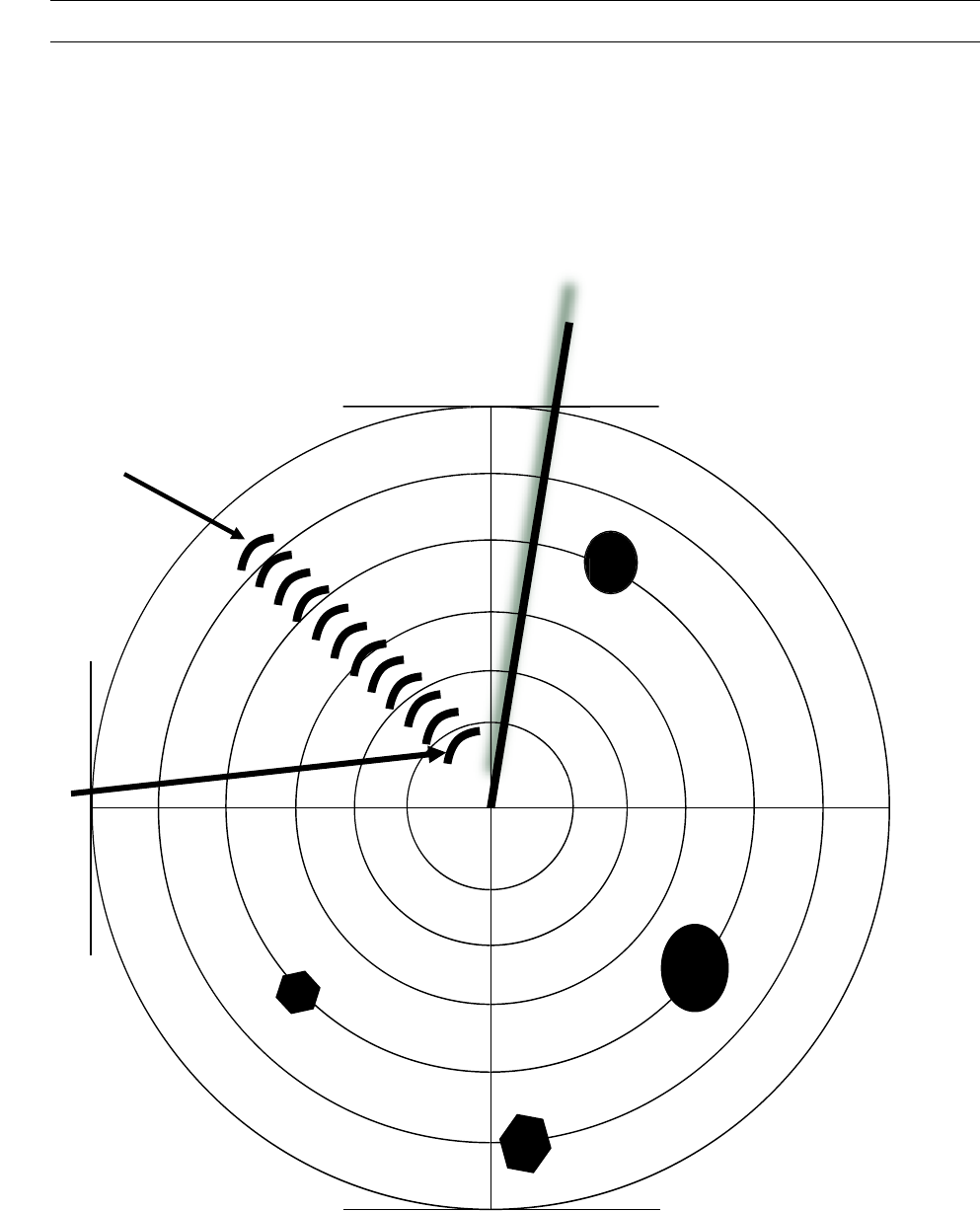
4 Y1-03-0171 Rev. A
SART Overview
The SART helps search and rescue services to quickly locate a life raft in the event of a rescue at
sea. The SART can either be stowed in a life raft, or mounted next to emergency exits and then
carried to the life raft in an emergency.
During an emergency, simply switch the SART on. When a vessel with marine X-band Radar
comes within 5 to 7 nautical miles of the life raft, the SART generates a distinctive “distress”
pattern on its Radar screen (See figure 1). The radar signal guides the rescuers directly to the
SART.
Distress
Pattern
SART
Location
Radar Screen
(Figure 1)

5 Y1-03-0171 Rev. A
Introduction
The SART is a Search and Rescue Transponder that provides location information to search radars
operating in the X-band (9.2 – 9.5 GHz). Once activated the SART detects the radar signal of the
search craft and sends a series of response pulses to the radar of the search craft that causes a series
of 12 equally spaced arcs to appear on the radar display (see figure 1). The arcs indicate the
direction to the SART location. The rescue craft follows the direction shown and proceeds to the
SART.
To achieve the maximum useful range the SART must be mounted at least 3.3 feet (1 meter) above
sea level and the rescue craft antenna must be 50 feet (15 meter) above sea level. Increasing the
height of the SART antenna will increase the range. For example, lashing the SART to the top of a
pole or an oar in the survival craft will increase the height and thus the range.
The International Maritime Organization (IMO) requires all vessels of more than 300 GRT to carry
at least one SART and vessels 500 GRT and over must carry at least two SART’s.
Figure 2 on page 6 shows the key features of your TelluSART MK III SART. The blue
activation switch ring is located under the top white cap. Located in the middle of the switch
ring is a red pull tab that must be removed to activate your SART. The pull tab locks the switch
ring in place and stops the SART from accidentally being placed in the ON position.
Turning the switch ring to the left allows you to test the SART. When held to the left, the SART
will beep once and continue to flash every four seconds. When released the switch ring will
return to the OFF position. TEST mode is identical to ON mode and will generate a “distress”
pattern on any Radar within range. Use TEST mode carefully to avoid false alarms.
To activate your SART in times of emergency, turn the blue activation switch ring to the left into
the test position and remove the red pull tab by pulling down on the lanyard attached to the tab.
Turn the blue activation switch ring to the right and into the ON position (see page 9 for
complete activation instructions).
When first turned ON, the SART will beep once and continue to flash every four seconds. The
SART is now operational. When responding to Radar the red light comes on continuously and
the SART will beep every two seconds. For best results a telescope pole is supplied on the
bottom of your SART to position the SART to the proper height above sea level.
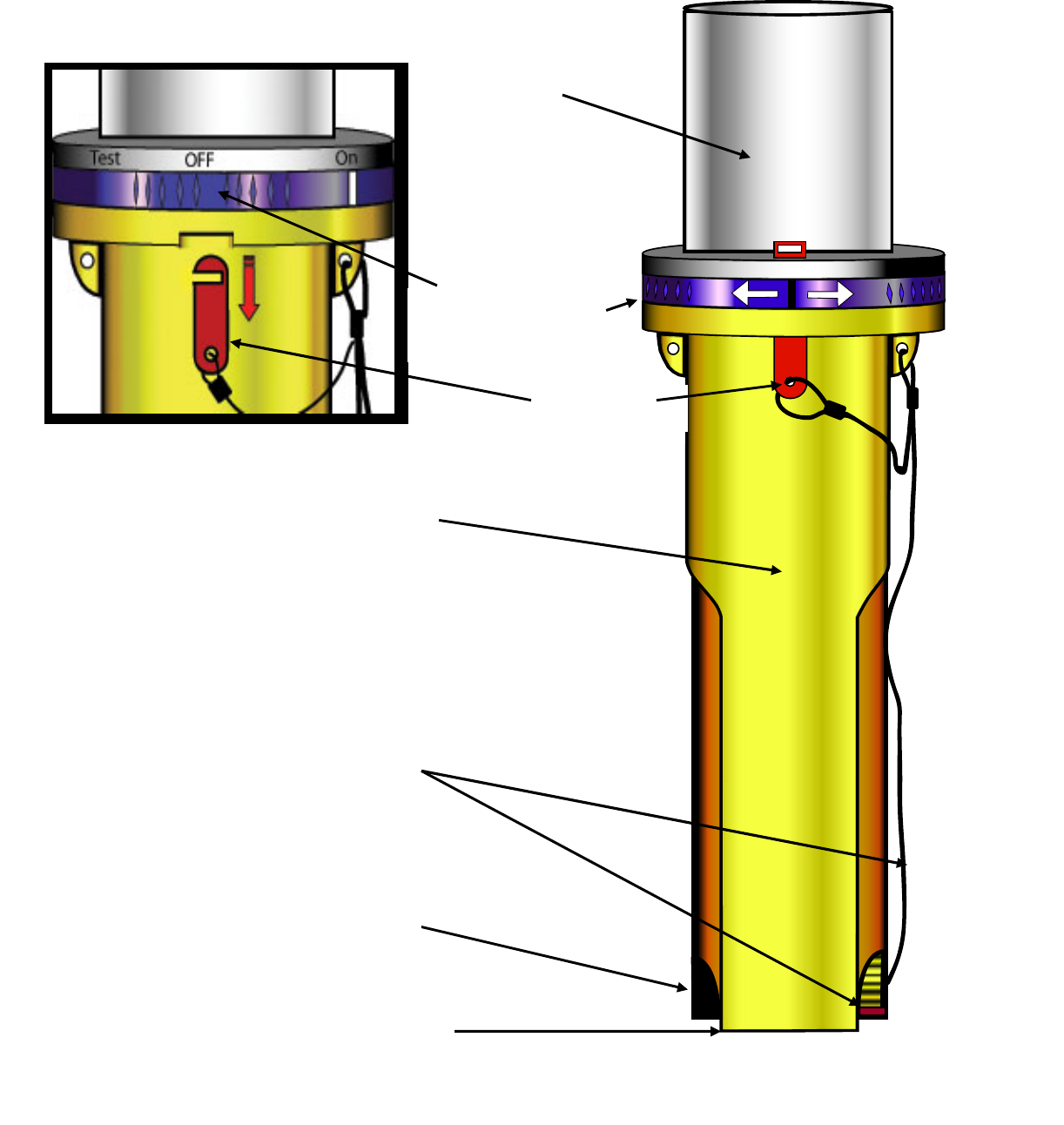
6 Y1-03-0171 Rev. A
Antenna
Activation Switch
Ring
Pull Tab
Control and
Battery
Housing
Lanyard
Telescopic
Pole
Rotate bottom cap
to release lanyard
and telescopic pole
Figure 2

7 Y1-03-0171 Rev. A
Specification
Tested & Approved to ..................................................................... IEC 1097-1
Meets IMO Resolutions...........................................................A.694(17), A.697(17)
Operating frequency .................................................................. 9.2 GHz - 9.5 GHz
Transmitter power............................................................................400mW min
Operating life (standby).................................................................. 96 hours min
Operating life (answering Radar) ....................................................8 hours min
Battery storage life...............................................................................5 years
Weight ..................................................................................................1.58 kg
Length ................................................................................................. 31.5 cm
Diameter.................................................................................................8 cm
Lanyard length .......................................................................................10 m
Compass safe distance ............................................................................2 m
Operating temperature ..................................................................-20°C to +55°C
Storage temperature ......................................................................-30°C to +65°C
SUITABLE FOR USE IN THE G.M.D.S.S.
WARNING:
Contains Lithium Battery
To avoid possible fire, explosion, leakage or burn hazard, do not
open, recharge, disassemble, heat above +70°C (+158°F) or
incinerate.
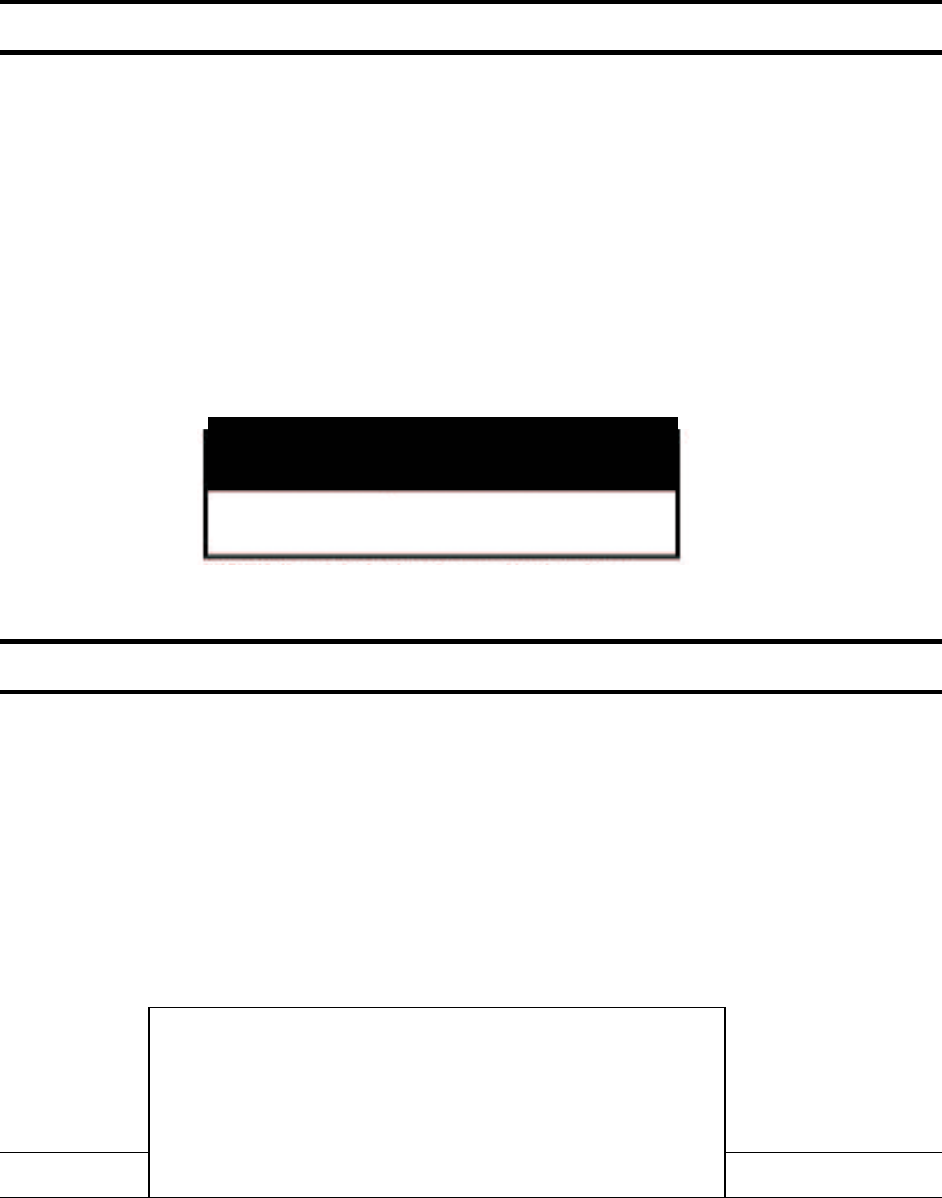
8 Y1-03-0171 Rev. A
Vessel name
The SART label has a space where you should mark the vessel name (see Figure 3). This can be
done as follows . . .
Using an indelible pen
With an indelible pen, you can write the vessel name directly onto the SART. Note however,
that some indelible inks will fade when exposed to strong sunlight, so an ultra-violet resistant
pen is recommended.
If the full vessel name will not fit in the space provided this does not matter. Use a recognized
abbreviation or the vessel's call sign instead.
Life raft stowage
The SART can either be stowed in a life raft or lifeboat or it can be installed next to an
emergency exit for carriage to the life raft in an emergency.
For life raft stowage the SART should be positioned for easy access in an emergency. If the
SART is hidden from view then clear labels should be used to show its position. For inflatable
life rafts the mounting bracket should be discarded to avoid the risk of damaging the life raft.
Activation
Remove the SART from the bracket.
DO NOT…
· Tie Lanyard to vessel
· Cover or obscure SART
· Apply paint to SART
Vessel Name Here
Figure 3
Name/Vessel Registration
Nom/Enregistrement De Navire
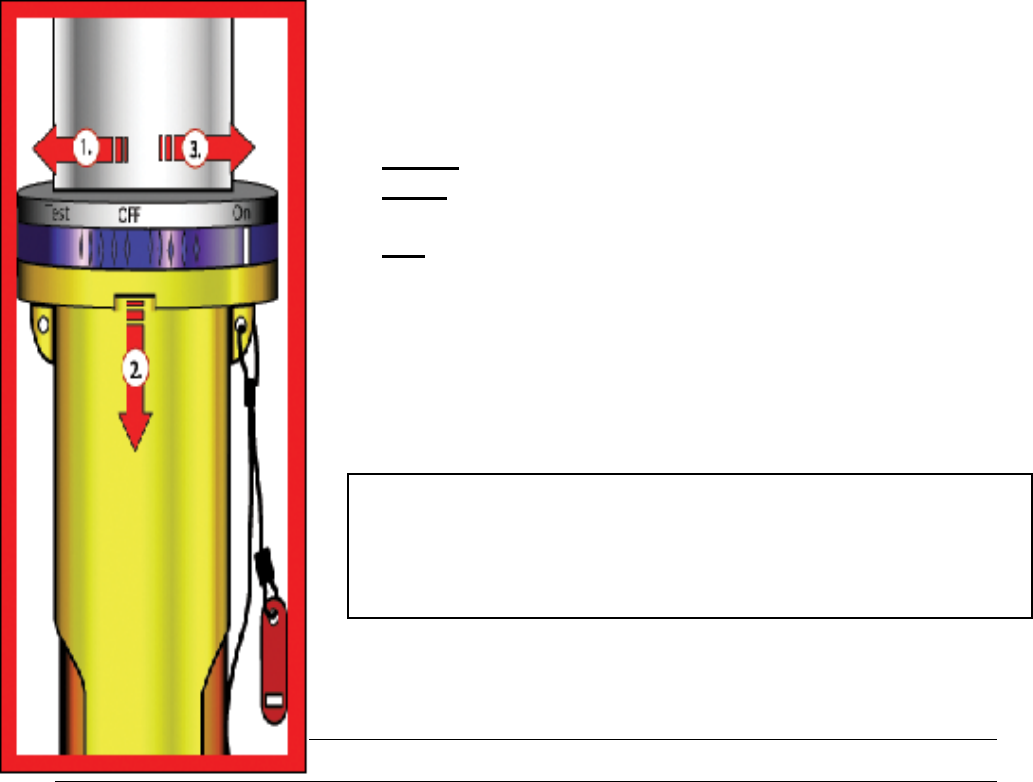
9 Y1-03-0171 Rev. A
Activation of the SART is completed by using the three-position switch ring (TEST-OFF-ON), as
shown in figure 4.
1. Turn the Blue activation switch ring to the left, placing the SART in test mode
2. Remove the red Pull Tab by pulling it down and completely out of the SART
3. Release the activation switch and guide it to the right until it is in the ON position
a. The SART will beep once and Flash every four seconds
b. The flashing red light indicates the SART is on
Turn the bottom cap of the SART and deploy the telescopic Pole to its maximum length
( 1 meter)
Remove lanyard and secure it to the life raft
When activated the SART has three Modes of operation.
These are:
· Receive – waiting for a valid interrogation by a radar signal.
· Reply – replying to a valid interrogation by a valid radar
signal.
· Test – self-test sequence that checks both indicator lights
and the buzzer.
Sequence of Operations
The SART has a primary indicating system and secondary indicating system.
WARNING
The SART must only be used in situations of Grave and
Imminent Danger.
Figure 4

10 Y1-03-0171 Rev. A
The primary system is the indicator lights and the secondary system is the buzzer. When the switch
is set to ON, the SART immediately enters the Test Mode. Here both red lights and the buzzer are
tested. Note that in noisy environments it may be difficult to hear the buzzer. After about one
second the SART goes to Receive Mode.
The SART remains in the Receive Mode until it detects a radar pulse. It then switches to the Reply
Mode and transmits a series of pulses. These pulses will appear on the interrogating radar display
as a series of arcs leading away from the SART‘s position. Both SART lights flash rapidly and the
buzzer emitting a pulsed sound at about one second interval indicate the Reply Mode. This
sequence is repeated each time a radar signal interrogates or transmits a valid radar signal to the
SART. When the radar signal interrogation stops the SART automatically returns to the Receive
Mode.
With a fully charged battery pack the SART will operate in Receive Mode for a minimum of 96
hours. After this time period it will still respond to normal interrogation radar signals for an
additional eight hours.
Pole Mounted SART
1. The TelluSART MK III is supplied with a telescopic pole to raise the SART one meter
above sea level
2. To operate, simply turn the bottom cap of the SART to release the pole
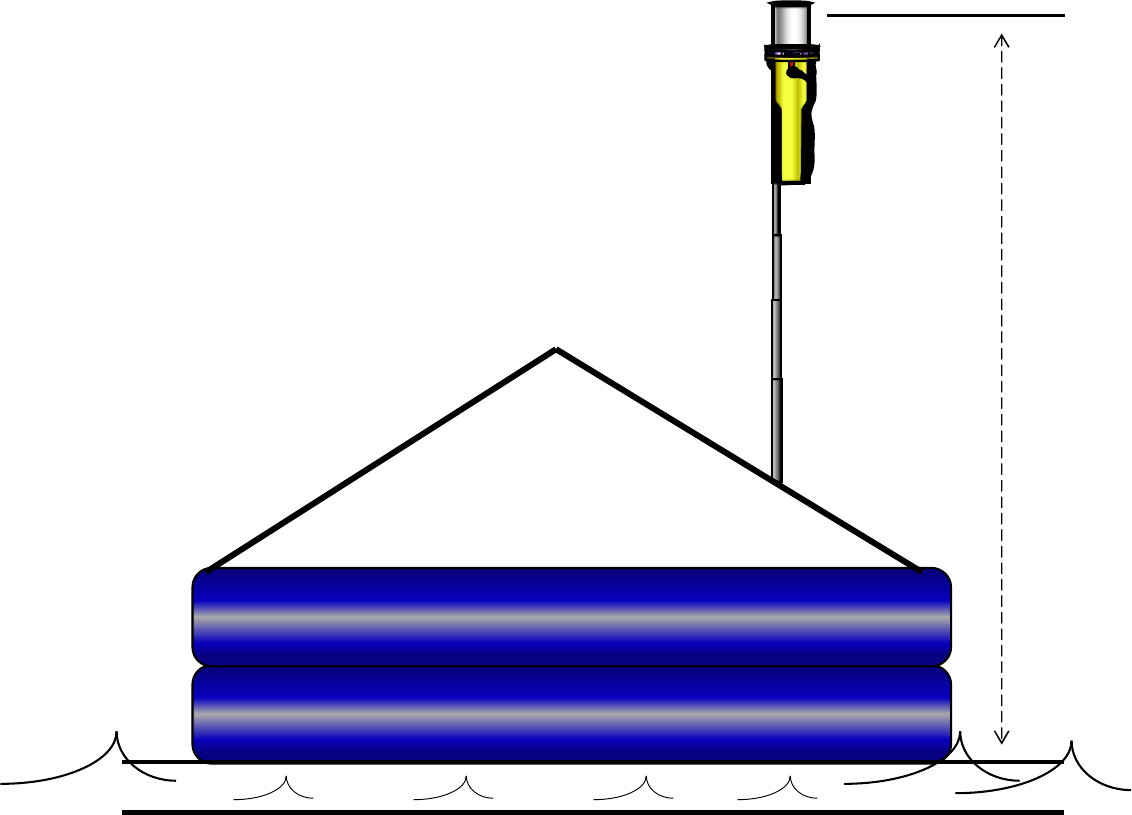
11 Y1-03-0171 Rev. A
1 Meter
Minimum
3. Pull the pole downward and extend it to its maximum length
4. To lock pole in position pull firmly across pole joints while twisting slightly
5. Tie Lanyard to life raft to ease retrieval should the SART fall into the water
6. Push SART through life raft observation port and place foot of pole in pocket at base of
life raft
7. Use life raft ties to hold SART pole near vertical
8. Ensure SART is not obscured by metal objects or inflatable Radar reflectors
9. Periodically check to see if SART is still vertical
Hanging SART
1. If no pole is provided, or if you prefer, you can suspend the SART from the canopy
support using the provided lanyard.
Figure 5
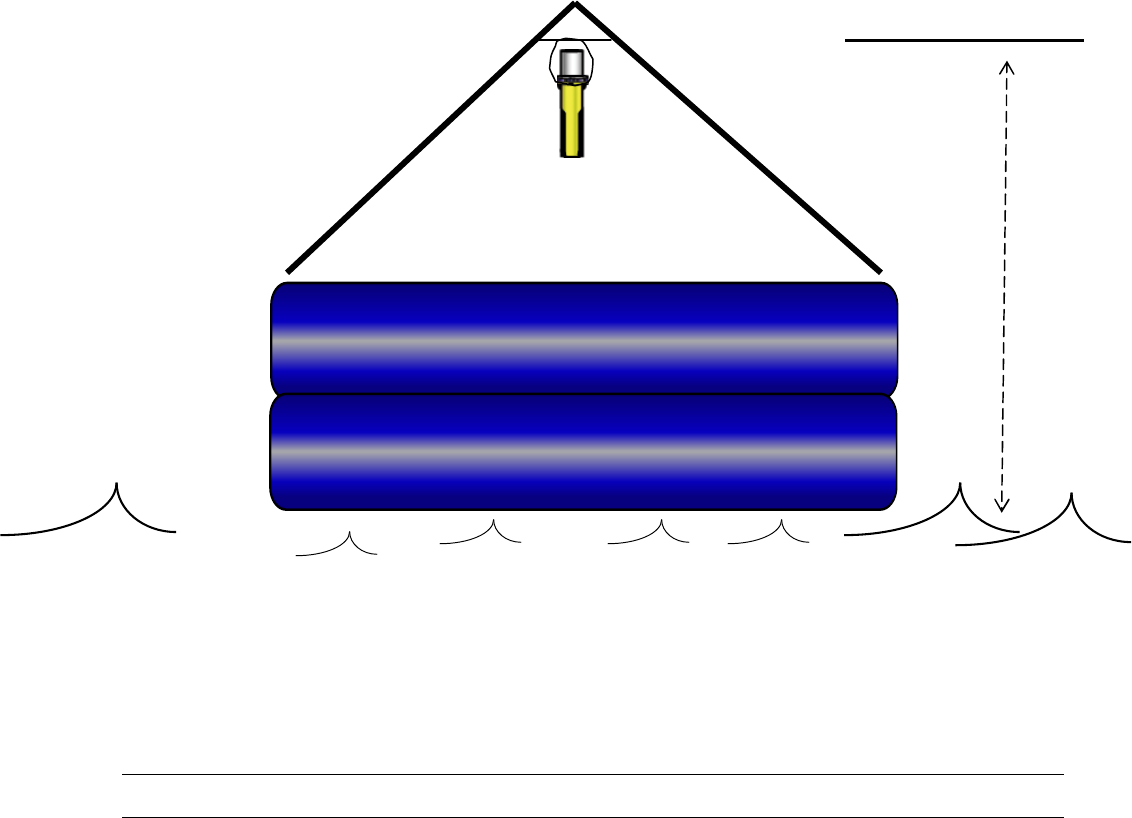
12 Y1-03-0171 Rev. A
1 Meter
Minimum
2. Loop the lanyard over the canopy support and back through the holes located directly
under the switch ring. Secure the lanyard with a knot to secure the SART in place.
3. The SART should be as high as possible and at least 1m above sea level. Ensure SART
is not obscured by metal objects or inflatable Radar reflectors.
Vessel Mounting
To deploy SART on board a distressed vessel, rather than a life raft, hang SART near vertical as
high as possible, with a clear view of the horizon. The SART must not be obscured by metal
bulkheads etc.
Figure 6
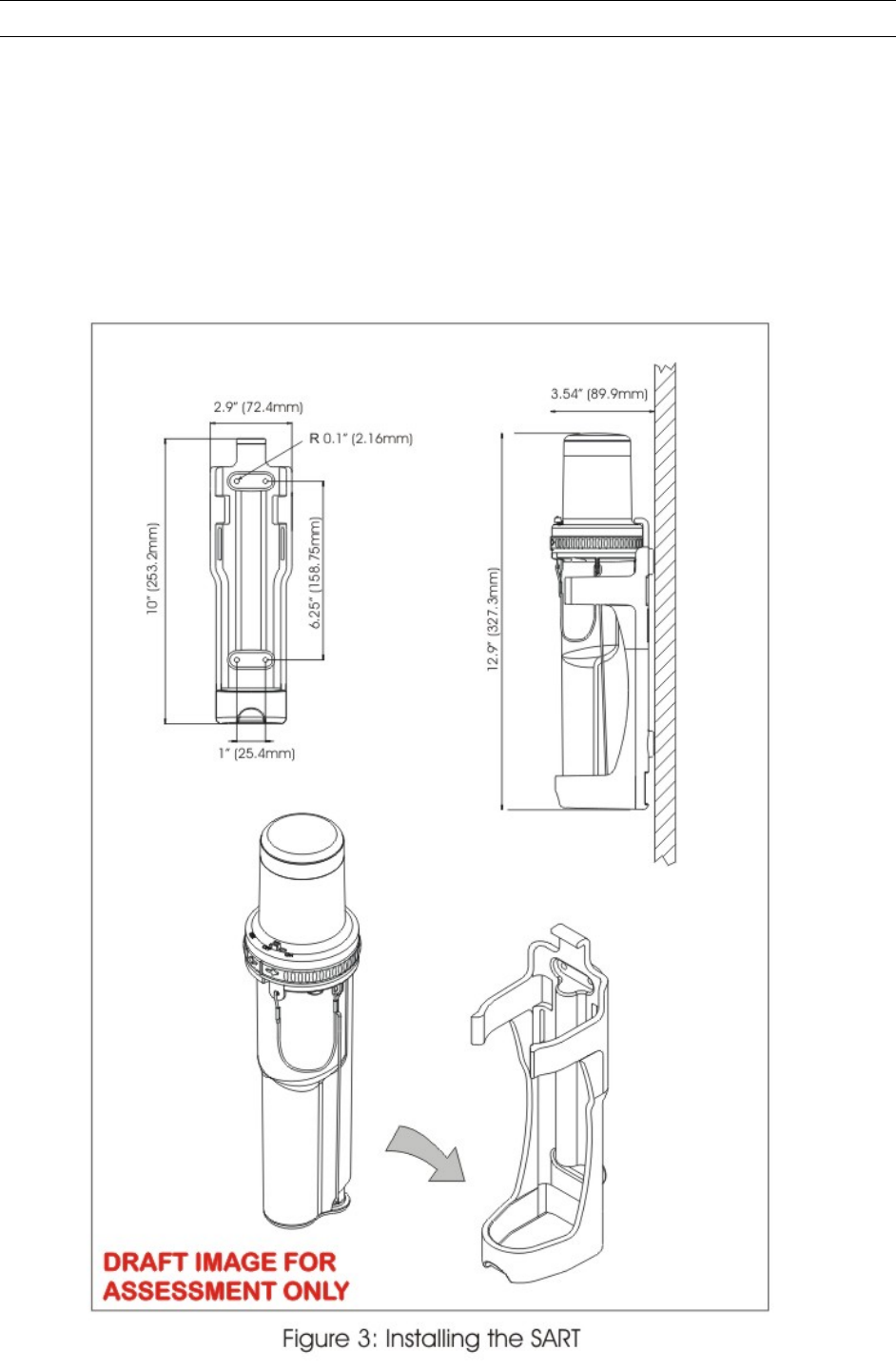
13 Y1-03-0171 Rev. A
Installation
The SART should be mounted inside the vessel, next to an emergency exit. Some ships require
2 SARTs one by a port exit and one by a starboard exit. Mount each SART as follows . . .
· Mount in plain view, at a convenient height, so that all staff can easily remover the SART.
· Positions at least 2 meter from the ship’s compass.
The SART mounting bracket should be bolted to a bulkhead using four (4) suitable M6 (1/4")
bolts. The equipment does not include mounting hardware for the bracket, as it will depend on the
bulkhead material and its thickness. Bracket mounting holes and SART mounting details are
shown in figure 7.
To install SART:
Remove SART from its packaging and check for shipping damage.
Perform the SART test (see Testing and Maintenance procedures on page 15).
Select a position for SART Mounting allowing sufficient space for the assembly.
! NOTE: The SART contains magnetic material.
Ensure that the position that you select is at least 7 feet
(2 meters) away from compass installations.
Drill holes to dimensions shown on figure 7.
Place bracket in position and secure to bulkhead as follows:
Remove the SART from the bracket.
Position bracket at the right visible spot.
Mark position of bracket fixing holes.
Drill holes to suit mounting fixtures.
Secure bracket to bulkhead.
Mount SART on the bracket (see figure 7).

14 Y1-03-0171 Rev. A
Testing and Maintenance
The SART' is a safety device, it must be regularly checked at least every 2 months as follows. . .
Visually inspect the casing for cracks & punctures.
Extend the pole and check that it operates correctly, and then return the pole to its housing.
Check to ensure the tether lanyard is neatly bundled and firmly secured to the SART. Ensure
the lanyard is NOT tied to any part of the vessel.
Check the battery expiry label shows sufficient battery life to cover the next routine voyage (See
figure 8).
Ensure the safety lock is in place and the integrity seal is not broken.
Confidence check
Push the switch ring to the left and into the test position and hold it there for 10 seconds.
Confirm the SART does either (a) or (b) below, then release the switch.
a) Bleeps 4-12 times and the red light flashes continuously (no Radar within range).
b) Bleeps every 2 seconds and the red light comes on continuously (Answering
Radar).
Multiple SART Interrogation Test
If your vessel has two TelluSART MK III SARTs on board they may be used to test each other.
This test requires that each SART is held independently 5 meters away from one another. Turn
each SART clockwise to the TEST position. Confirm that each SART does the following:
· Bleeps every two seconds
· The red light comes on continuously
The two SARTs will appear to be communicating with one another.
Functional Test (At least once a year carry out a functional test)
Get someone to watch the Radar screen, while you take the SART to the ships bow or at least
20m from the Radar antenna. Hold the switch in its TEST position for no more than 10 seconds.
Confirm a "distress" pattern is generated on the Radar screen. At close range the pattern often
appears as a series of concentric circles.
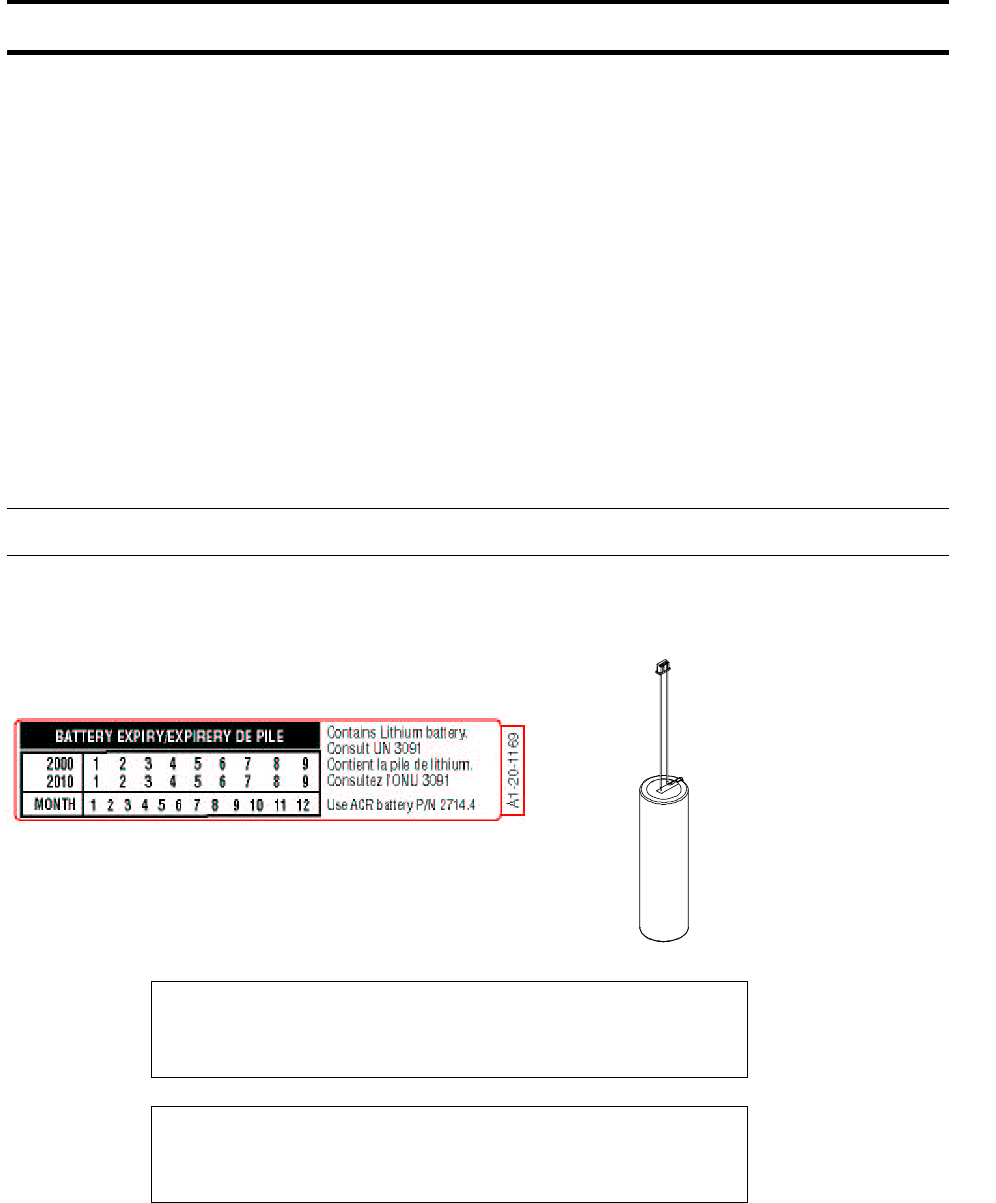
15 Y1-03-0171 Rev. A
Servicing
If the SART fails any of its monthly checks, the SART must be returned to the supplier or an
approved service agent for investigation and/or servicing.
If the battery is beyond its expiry date, the SART must be returned for a battery change. The
battery is NOT user serviceable; do NOT attempt to change it.
If the SART has been used in an emergency or its integrity seal is broken, then the SART must
be returned for a battery change.
Contact your local supplier in the first instance; he can advise you on your local approved service
agent. Otherwise, contact the Customer Service Manager at the address given in the front of
this manual.
When returning your SART, ensure you follow the transportation instructions on page 17.
Battery Pack Replacement
Regulations require that the battery pack be replaced every 5 years. A label on the lower section of
the SART housing shows the expiry date of the battery pack (see figure 8).
! NOTE: The battery pack must be replaced if the SART
has been used in an emergency or if the SART has
been activated inadvertently (integrity seal broken).
! CAUTION: The battery pack CANNOT be recharged;
attempts to recharge the battery pack could result in an
explosion.
Replacement of the SART battery pack must be performed by ACRSA or by an ACR authorized
dealer; the cost of this replacement is the responsibility of the owner.
Figure 8: Replacement Battery label

16 Y1-03-0171 Rev. A
Transportation
Your SART contains a Lithium battery. International regulations on shipment of Lithium require
special warning labels. When returning your SART, ensure you comply with the following
instructions. . . .
1) Pack the SART in a strong cardboard box.
2) Write these words on the outside of the box . . .
3) Stick a "Miscellaneous 9" label on the box
4) Write your name and address on the box.
5) Check with your local transportation authority for additional or different requirements.
Contact your supplier or the manufacturer's Customer Service Manager with any queries on
shipment.
Note on Serial Number
The serial number on the SART is indicated on the base of the SART.
LITHIUM BATTERIES CONTAINED IN EQUIPMENT
CLASS 9 UN 3091 Net Wt of Lithium 7.5 Grams
PACKING INSTRUCTION 912, II

17 Y1-03-0171 Rev. A
Technical Specifications
General
Meets the requirements of: Global Maritime Distress and Safety Systems
(GMDSS) according to IMO amendment to chap
III of the 1974 SOLAS Convention, as well as
part 80 of the FCC Rules
International type approval in
accordance with:
IEC 1097-1 1992, I-ETS 300 151
Designed to meet: RTCM Paper 111-92/SC113-36
(Ninth Draft SART Standard)
Frequency: 9.2 GHz to 9.5 GHz
Antenna
Polarization: Horizontal
Azimuth beam width: Omni-directional within 2 dB
Vertical beam width: ± 12.5°
Transmitter
Response delay: 0.5 µs
Forward sweep time: 7.5 µs ± 1.0 µs
Return sweep time: 0.4 µs ± 0.1 µs
Power output: 400 mW EIRP
Receiver
Effective sensitivity: -50 dBm
Battery
Receive mode operation: 96 hours minimum

18 Y1-03-0171 Rev. A
Reply mode operation: 8 hours continuous while being interrogated by
an X-band radar with a pulse repetition
frequency of 1 kHz (at extreme temperatures).
Battery life: 5 years
Environmental
Operating temperature -4°F to +131°F (-20°C to +55°C)
Storage temperature -22°F to +140°F (-30°C to +65°C)
Physical
Length 18 in (459 mm) excluding pole
Diameter: 3.5 in (90 mm) mid body
Weight 4.4 lbs (2 kg) including pole
Electromagnetic Compatibility
Meets the applicable requirements of BS EN 60945: 1997.
Spare Parts for the SART
PH0205-0003-AA1 Main Base Assembly
(includes the Telescopic Pole and Lanyard
Assembly)
PH0205-0100-AA1 Battery Assembly
PH0205-0211-AM0 Clamp Bracket Molding
PH0200-0010-AM0 Strap Molding

19 Y1-03-0171 Rev. A
Warranty
The SART or Replacement Battery is guaranteed by the manufacturer to be free of defects
in materials and workmanship for a period of one year from the date of the original
purchase. This warranty is extended only to the original purchaser of the unit.
During the warranty period the manufacturer will repair or, at the manufacturer's option,
replace a defective unit at no cost to the owner of the SART for materials and labor.
Transportation charges are the responsibility of the owner of the SART. The unit must be
packaged correctly and shipped prepaid to the manufacturer or an authorized service
center. It will be returned via collect shipping.
The warranty is void if the unit has been damaged through accident, misuse, improper
installation, or during transportation. The warranty is also void if the security seal on the
SART has been broken.
The liability of the manufacturer shall be limited to the repair or replacement of a
defective unit during the warranty period. The manufacturer shall not be liable for
injuries or damages arising from the handling, possession or use of this product by the
purchaser or others that obtain it through the purchaser.
For full and complete warranty terms the owner is referred to the warranty card provided.
To validate this warranty, the enclosed warranty card must be completed and mailed
before putting the unit into service.